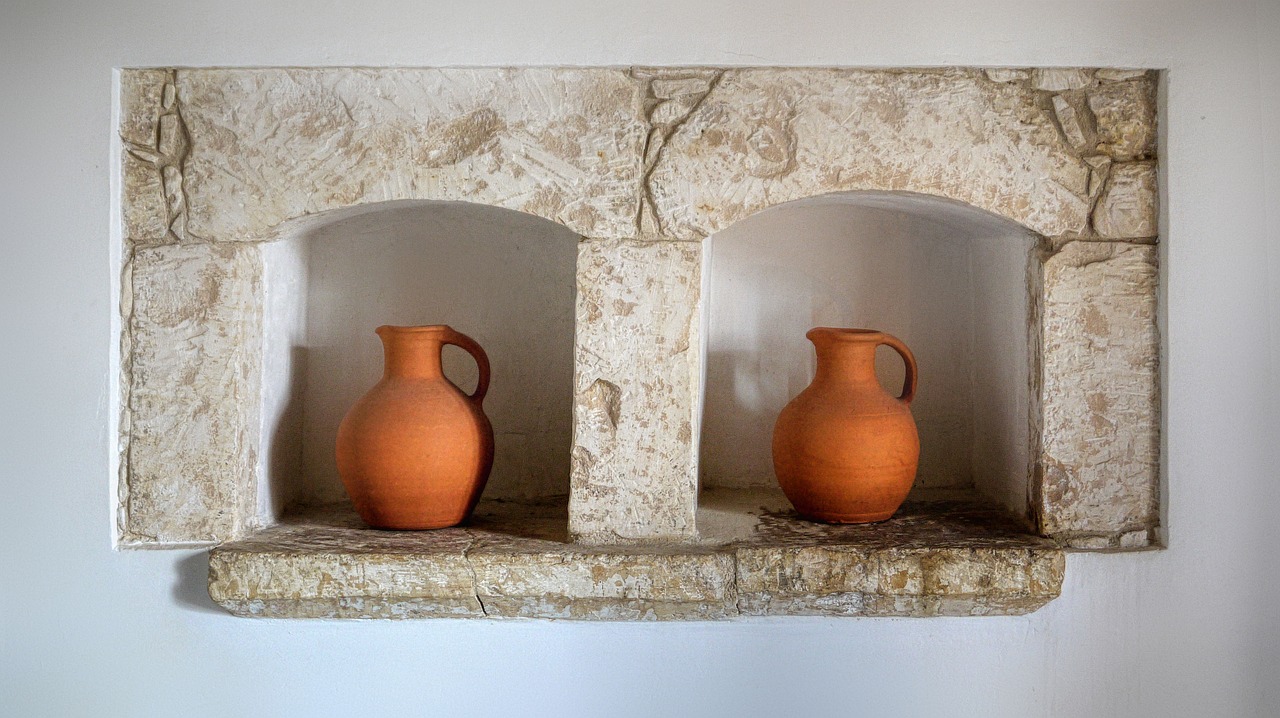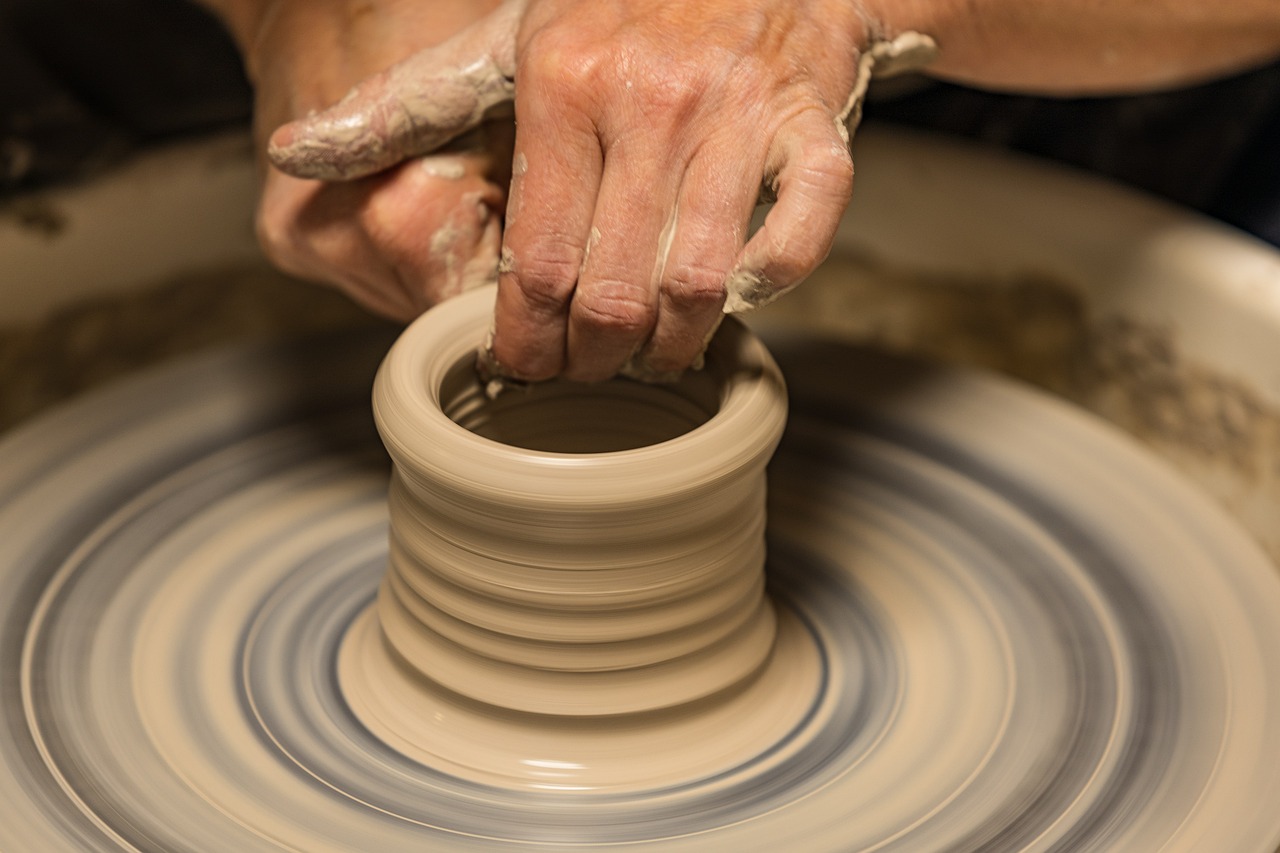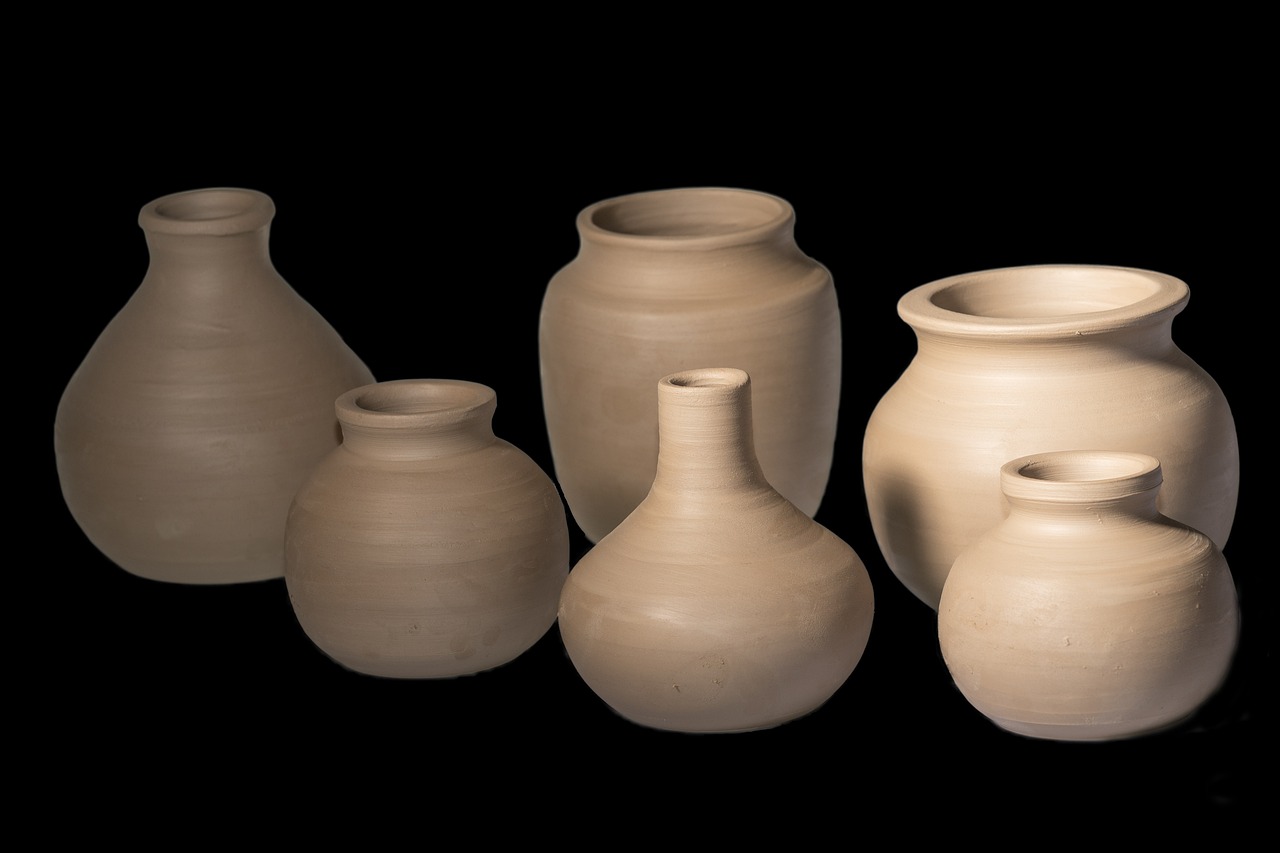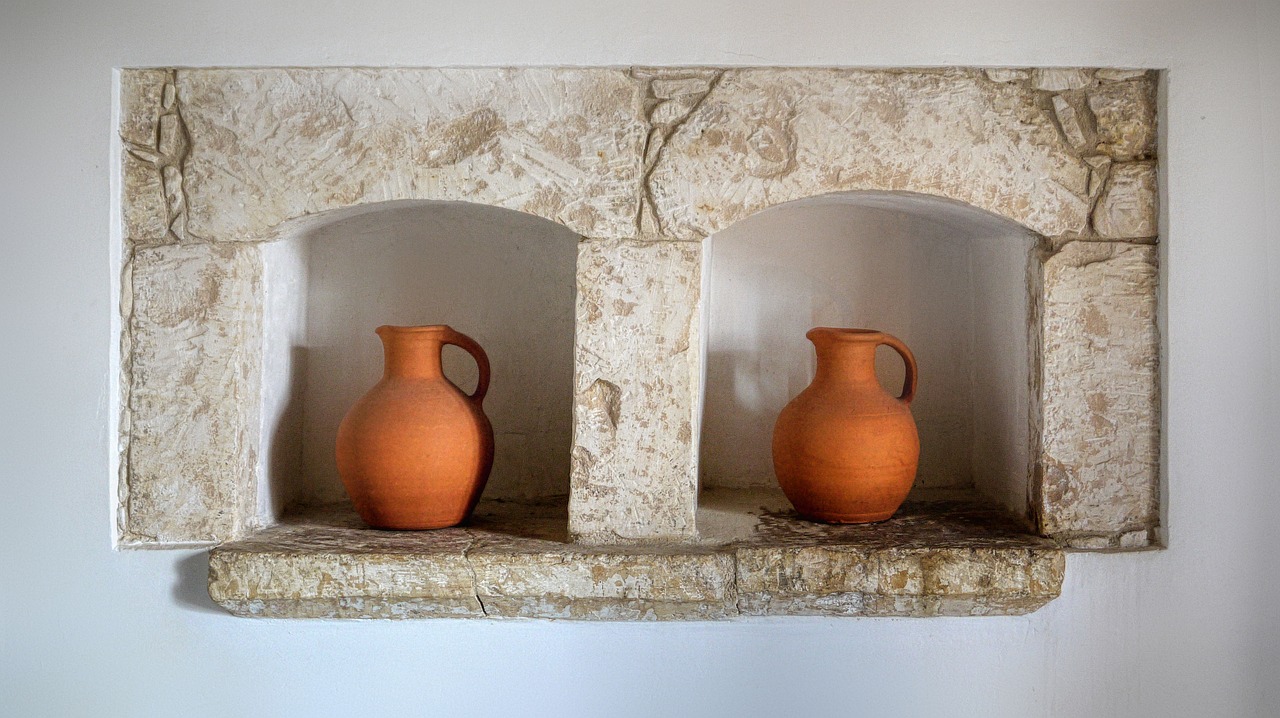How to Start a Pottery Business from Home
Starting a pottery business from the comfort of your home can be an exciting and fulfilling venture. Imagine shaping clay with your hands, creating beautiful pieces that not only serve a purpose but also bring joy to others. If you’ve ever thought about turning your passion for pottery into a profitable business, you're in the right place! This article provides a comprehensive guide to help you navigate the journey of launching your pottery business, covering essential steps, tips, and best practices for success.
Before diving headfirst into your pottery business, it’s crucial to understand the pottery market. Think of the market as a vast ocean; you wouldn’t want to set sail without knowing the currents and tides, right? Start by researching current trends in pottery. Are people leaning towards minimalistic designs or vibrant, colorful pieces? What types of pottery are in demand—functional items like mugs and plates or decorative pieces? Consider surveying potential customers or browsing social media platforms like Instagram and Pinterest to gather insights on customer preferences. Also, keep an eye on your competitors. What are they offering, and how can you differentiate your products? Understanding these dynamics will help your business stand out in a crowded marketplace.
Now that you have a grasp on the market, it’s time to talk about the essentials. Investing in the right tools and materials is vital for producing quality pottery. Your toolkit will be the backbone of your creative process. Here’s a quick overview of the essential equipment you’ll need:
- Pottery Wheel: A must-have for shaping your clay.
- Kiln: Essential for firing your creations.
- Clay: Choose from earthenware, stoneware, or porcelain based on your style.
- Tools: Sculpting tools, sponges, and trimming tools will help refine your work.
- Glazes: These will add color and finish to your pottery.
Having the right equipment not only enhances the quality of your work but also makes the process more enjoyable. Investing in good tools can be a bit pricey, so consider starting small and upgrading as your business grows.
Creating an efficient and inspiring workspace is key to your productivity. Your workspace should be a reflection of your creativity and should motivate you to produce your best work. Here are some tips for setting up a functional and organized pottery studio at home:
- Location: Choose a space with good ventilation and natural light.
- Organization: Keep your tools and materials neatly arranged for easy access.
- Comfort: Invest in a sturdy chair and a work table that suits your height.
Think of your workspace as your creative sanctuary. The more comfortable and organized it is, the more you’ll enjoy the process of making pottery.
Before launching your business, honing your pottery skills is essential. Consider taking classes or watching online tutorials to improve your craftsmanship. There’s a wealth of resources available, from local community colleges to online platforms like YouTube. Practice makes perfect, and the more you create, the better you’ll become. Don't be afraid to experiment with different techniques and styles; after all, pottery is as much about self-expression as it is about skill.
A well-structured business plan is crucial for success. Think of it as your roadmap; without it, you might find yourself lost along the way. Your business plan should include:
- Goals: What do you hope to achieve?
- Target Market: Who are your ideal customers?
- Financial Projections: How much do you expect to earn and spend?
By outlining these components, you’ll have a clear vision of where you’re headed and how to get there.
Effective marketing strategies are necessary to attract customers. Think of marketing as the megaphone that amplifies your voice in the crowded marketplace. Utilize social media platforms, create an engaging website, and consider participating in local craft fairs or markets. Collaborating with local businesses can also help you gain visibility. Remember, the more people see your work, the more likely they are to buy it!
In today's digital age, an online presence is vital. Setting up an online store can help you reach a broader audience and boost sales. Platforms like Etsy, Shopify, or even your own website can serve as a virtual storefront. Ensure your online store is visually appealing and easy to navigate. High-quality photos of your pottery can make a significant difference in attracting customers.
Determining the right pricing strategy is crucial for profitability. You want to make sure you cover your costs while still being competitive. Consider factors such as material costs, time spent creating each piece, and market demand. A well-thought-out pricing strategy can make or break your business.
Understanding the financial and legal aspects of running a pottery business is essential. This includes budgeting, bookkeeping, and necessary permits. Keep track of your expenses and earnings to ensure financial health. Consult with a financial advisor if needed, and don’t forget to look into any permits or licenses required for your business.
Q: Do I need a degree to start a pottery business?
A: No, you don’t need a degree, but honing your skills through classes can be beneficial.
Q: What is the best clay for beginners?
A: Earthenware is often recommended for beginners due to its ease of use.
Q: How do I find customers for my pottery?
A: Utilize social media, craft fairs, and word-of-mouth to attract customers.
Starting a pottery business from home can be a rewarding journey filled with creativity and self-expression. With the right tools, skills, and marketing strategies, you can turn your passion into a thriving business. So roll up your sleeves, get your hands dirty, and let your creativity flow!

Understanding the Pottery Market
Before diving into the exciting world of pottery, it's essential to grasp the nuances of the pottery market. Just like a potter shapes clay, you need to mold your understanding of market dynamics to ensure your creations resonate with potential customers. The pottery market is not just about crafting beautiful pieces; it's about knowing what people want, how trends shift, and recognizing who your competitors are.
First off, let's talk about trends. The pottery landscape is constantly evolving, influenced by various factors such as home decor styles, sustainability movements, and even social media. For instance, the rise of minimalism has led to a demand for clean, simple designs, while the bohemian aesthetic embraces more intricate, colorful pottery. By keeping an eye on platforms like Instagram and Pinterest, you can stay updated on what styles are gaining traction and tailor your creations accordingly.
Next, understanding your target audience is crucial. Who are you creating for? Are your pieces aimed at young couples looking to decorate their first home, or perhaps art enthusiasts searching for unique, handcrafted gifts? Knowing your audience helps you make informed decisions about the types of pottery you should focus on. For example, if you're targeting eco-conscious consumers, consider using sustainable materials and promoting your commitment to the environment.
Additionally, conducting a competitive analysis can provide valuable insights. Take some time to research other pottery businesses in your area or online. What do they offer? What are their price points? By analyzing their strengths and weaknesses, you can identify gaps in the market that your pottery business could fill. This could be anything from unique glazing techniques to specializing in a specific type of pottery, such as functional kitchenware or decorative art pieces.
Furthermore, the importance of customer feedback cannot be overstated. Engaging with your audience through social media or local craft fairs allows you to gather insights directly from potential buyers. Ask them what they like, what they wish they could find, and how much they are willing to spend. This feedback loop not only helps you refine your product offerings but also builds a community around your brand.
In summary, understanding the pottery market is about more than just making beautiful items. It requires a keen awareness of trends, a clear vision of your target audience, and a strategic approach to analyzing competitors. By investing time in market research, you can create pottery that not only delights the eye but also meets the needs and desires of your customers. Remember, in the world of pottery, knowledge is as important as skill, and the more you know, the better equipped you'll be to succeed.
- What are the current trends in pottery? Trends can include minimalist designs, sustainable materials, and unique glazing techniques.
- How do I identify my target audience? Conduct surveys, engage on social media, and attend local craft fairs to understand your potential customers better.
- What should I look for in competitors? Analyze their product offerings, price points, and customer engagement strategies to find market gaps.

Essential Equipment and Supplies
This article provides a comprehensive guide on launching a pottery business from the comfort of your home, covering essential steps, tips, and best practices for success.
Before starting a pottery business, it's crucial to understand the market dynamics, including trends, customer preferences, and potential competitors to ensure your business stands out.
When embarking on your pottery journey, having the right tools and materials is akin to a painter needing a canvas and brushes. The essential equipment and supplies you'll need can make or break your creative process, so let’s dive into what you should consider. First and foremost, a quality pottery wheel is indispensable. It’s your main tool for shaping clay, so investing in a reliable model will pay off in the long run. Look for features like adjustable speed and a sturdy base to ensure stability while you work.
Next, let’s talk about clay. There are various types available, such as earthenware, stoneware, and porcelain, each offering unique qualities and firing temperatures. It’s wise to experiment with a few different types to find which one resonates with your style. Additionally, you’ll need a kiln, which is essential for firing your creations. If budget constraints are a concern, consider joining a local pottery studio that might offer kiln access.
Now, don’t forget about the smaller tools that can enhance your craftsmanship. Here’s a quick rundown of some must-have supplies:
- Tools for shaping: Wooden rib, metal scraper, and sponge.
- Cutting tools: Wire cutter and knife for trimming your pieces.
- Glazes: A variety of colors to finish your pottery beautifully.
In addition to tools and materials, having a dedicated workspace is crucial. A sturdy table or workbench, adequate storage for your supplies, and proper ventilation if you're working with glazes will help you maintain an organized and efficient studio. Lighting is another important aspect; good lighting can significantly improve your ability to see details and imperfections in your work.
As you gather your equipment, consider creating a checklist to ensure you don’t overlook anything. Here’s a simple example:
| Equipment | Description |
|---|---|
| Pottery Wheel | A device for shaping clay into pots and other forms. |
| Kiln | A furnace for firing pottery, essential for hardening and finishing pieces. |
| Clay | Material used to create pottery; varies in type and characteristics. |
| Glazes | Colored coatings applied to pottery for decorative purposes. |
With the right tools in hand, you’ll be well on your way to creating stunning pottery. Remember, investing in quality equipment not only enhances your work but also boosts your confidence as you explore your artistic potential. So, gear up and let your creativity flow!
Before launching your business, honing your pottery skills is essential. This section covers various techniques and resources to improve your craftsmanship and artistic abilities.
A well-structured business plan is crucial for success. This section guides you through the essential components of a pottery business plan, including goals, target market, and financial projections.
Effective marketing strategies are necessary to attract customers. Here, we explore various marketing channels and techniques to promote your pottery business and increase visibility.
In today's digital age, an online presence is vital. This section discusses how to set up an online store to reach a broader audience and boost sales.
Determining the right pricing strategy is crucial for profitability. This section provides insights into how to price your pottery products effectively while considering costs and market demand.
Understanding the financial and legal aspects of running a pottery business is essential. This section covers budgeting, bookkeeping, and necessary permits to ensure compliance and financial health.
- What type of clay is best for beginners? Earthenware is often recommended due to its workability and lower firing temperature.
- Do I need a kiln to start a pottery business? While a kiln is essential for firing, you can also consider renting space in a local pottery studio.
- How do I market my pottery? Utilize social media platforms, craft fairs, and an online store to reach a wider audience.

Setting Up Your Workspace
Creating an efficient and inspiring workspace is key to your productivity when starting a pottery business from home. Imagine stepping into a space where creativity flows as freely as the clay you mold. Your workspace should not only be functional but also serve as a sanctuary for your artistic expression. To achieve this, consider the following essential elements:
First and foremost, choose a dedicated area in your home that can accommodate your pottery activities. Ideally, this should be a space that can handle some mess, as pottery can be a bit gritty. A garage, basement, or even a spare room can work well. Make sure there's ample natural light; the more you can see your work, the better. Think of your workspace as a blank canvas—what colors, textures, and layouts inspire you?
Next, invest in sturdy work surfaces. A solid table or workbench is essential for kneading clay and shaping your pieces. You might want to consider a table that can withstand some wear and tear, as pottery can be quite demanding. Additionally, having a potter's wheel, if you're planning on throwing pottery, will be a significant investment. Remember, quality tools can make a world of difference in your creations.
Don't forget about storage! Organizing your tools and materials will save you time and frustration. Use shelves, bins, and drawers to keep everything from clay to glazes within easy reach. You might even want to label your storage containers. Think of it as your treasure chest—every time you open it, you should feel excited about what you can create!
Moreover, consider your ventilation. Working with clay and glazes can release dust and fumes, so having good airflow is crucial. If your workspace is in a basement or a room without windows, a good ventilation system or air purifier can help keep the air fresh and safe.
Lastly, make your workspace a reflection of you. Hang up some of your favorite pottery pieces for inspiration, play your favorite music, or even add plants to liven up the space. Your workspace should energize you! After all, the environment you create will directly influence your creativity and productivity.
In summary, setting up your pottery workspace is about more than just functionality; it's about creating a space that inspires you to unleash your creativity. By focusing on the essentials—location, work surfaces, storage, ventilation, and personal touches—you'll be well on your way to crafting beautiful pottery in an environment that feels just right.
- What is the best location for a pottery workspace? A garage, basement, or spare room with good ventilation and natural light is ideal.
- What equipment do I need to start? Essential tools include a sturdy work table, potter's wheel, and storage solutions for your materials.
- How can I keep my workspace organized? Use labeled bins, shelves, and drawers to store your tools and materials efficiently.
- Do I need special ventilation for my workspace? Yes, ensuring good airflow is crucial for safety when working with clay and glazes.

Developing Your Pottery Skills
Before you dive headfirst into the world of pottery, it's essential to hone your skills and develop a solid foundation. Think of pottery as a dance; the more you practice, the more fluid and graceful your movements become. The journey to becoming a skilled potter is both exciting and challenging, and there are numerous ways to enhance your abilities. Whether you’re a complete novice or have some experience under your belt, investing time in skill development will pay off immensely in the long run.
First and foremost, consider taking pottery classes. Local community colleges, art schools, and even some craft stores offer courses that cater to various skill levels. These classes provide hands-on experience, which is invaluable. You’ll learn from experienced instructors who can offer personalized feedback and guidance. Plus, being surrounded by fellow pottery enthusiasts can ignite your creativity and motivate you to push your boundaries.
However, if formal classes aren’t an option, don’t fret! There are countless online resources available. Websites like YouTube offer a treasure trove of tutorials covering everything from basic techniques to advanced glazing methods. You can learn at your own pace, rewind when you need to, and practice in the comfort of your home. Just remember, practice makes perfect. Set aside time each week to work on your skills, even if it’s just for an hour or two.
Another effective way to develop your pottery skills is through experimentation. Allow yourself the freedom to play with different techniques, styles, and materials. For instance, try hand-building versus wheel-throwing to see which method resonates with you more. Experiment with various types of clay, glazes, and firing techniques. This exploration can lead to unique creations and help you discover your artistic voice.
Don’t underestimate the importance of joining pottery communities, both online and offline. Engaging with fellow potters can provide you with support, inspiration, and constructive criticism. Websites like Instagram and Pinterest are fantastic platforms to showcase your work and connect with other artists. You can also join local pottery clubs or forums where you can share tips, ask questions, and participate in challenges. This sense of community can be incredibly motivating and help you stay committed to your craft.
As you progress, consider documenting your journey. Keep a pottery journal where you can jot down your thoughts, techniques you've tried, and what worked or didn’t. This not only helps you track your progress but also serves as a reference for future projects. Additionally, taking photos of your creations can help you see how far you've come, and these images could be useful for your future marketing efforts.
Lastly, remember that developing your pottery skills is a continuous journey. Even the most skilled potters are always learning and evolving. Embrace the process, celebrate your successes, and don’t be discouraged by setbacks. Each piece you create is a step toward mastering your craft. So, roll up your sleeves, get your hands dirty, and let your creativity flow!
- How long does it take to become proficient in pottery? The timeline varies from person to person. With regular practice, you can expect to see significant improvement within a few months.
- Do I need to invest in expensive equipment to start? Not necessarily. You can start with basic tools and gradually upgrade as you develop your skills.
- Can I learn pottery on my own? Yes! Many potters are self-taught. Online resources and books can help you learn at your own pace.

Creating a Business Plan
Launching a pottery business without a solid plan is like trying to navigate a ship without a compass—you're bound to get lost! A well-structured business plan acts as your roadmap, guiding you through the twists and turns of entrepreneurship. It’s not just a document; it’s your vision for success, a tool that can help you articulate your goals, strategies, and financial forecasts. So, what should you include in your pottery business plan?
First, you’ll want to start with an executive summary. This section provides a snapshot of your business idea, your mission statement, and what sets you apart from competitors. Think of it as your elevator pitch; it should be engaging enough to capture interest but concise enough to convey the essentials.
Next up is the market analysis. Here, you’ll dive into understanding your target audience, their preferences, and the current trends in the pottery market. Consider questions like:
- Who are your ideal customers?
- What are their buying habits?
- Who are your main competitors, and what do they offer?
By answering these questions, you can identify opportunities for your pottery business. For instance, if you discover that handmade, eco-friendly pottery is trending, you might want to focus on that niche.
Now, let’s talk about your marketing strategy. This part of your business plan outlines how you’ll attract and retain customers. Will you use social media, local craft fairs, or perhaps collaborate with local boutiques? It’s crucial to think about your brand identity and how you want to present your pottery to the world. Consistency in branding can make a significant difference in how your audience perceives your products.
Next, you’ll need to include an operational plan. This section should detail your production process, from sourcing materials to shipping finished products. Will you be working alone, or do you plan to hire employees? Also, consider your workspace—do you have enough room to create and store your pottery? Clarifying these details will help you run your business smoothly.
Financial projections are another critical component. You’ll need to estimate your startup costs, ongoing expenses, and potential revenue. This will not only help you understand your financial needs but also prepare you for discussions with potential investors or lenders. A simple table can help you lay out these figures:
| Expense Category | Estimated Cost |
|---|---|
| Equipment and Supplies | $2,000 |
| Marketing | $500 |
| Rent/Utilities | $300/month |
| Miscellaneous | $200 |
Finally, don’t forget to include an exit strategy. While it may seem premature to think about the end before you've even started, having a plan in place can provide peace of mind. Whether you envision passing the business on to a family member or selling it to a larger company, outlining your exit strategy can help you make informed decisions as you grow.
In conclusion, creating a comprehensive business plan is not just a formality; it’s a vital step toward realizing your dreams of running a successful pottery business. By taking the time to flesh out each section, you’ll arm yourself with the knowledge and confidence needed to navigate the pottery world. So grab your favorite mug, sit down with a notebook, and start crafting your masterpiece of a business plan!
1. How long should my business plan be?
A typical business plan ranges from 15 to 30 pages, depending on the complexity of your business. Keep it concise but comprehensive.
2. Do I need to have a business plan if I’m starting small?
Absolutely! Even if you’re starting small, a business plan helps you clarify your vision and stay focused on your goals.
3. Can I update my business plan later?
Yes! Your business plan is a living document. As your business grows and changes, so should your plan.

Marketing Your Pottery
When it comes to launching your pottery business, marketing is the lifeblood that will keep your creative dreams alive and thriving. Imagine your beautiful, handcrafted pottery sitting on a shelf, waiting for someone to discover it. How do you ensure that your unique creations don’t just gather dust? The answer lies in effective marketing strategies that resonate with your target audience.
First, it’s essential to identify your target market. Are you focusing on local art enthusiasts, eco-conscious consumers, or perhaps gift buyers? Understanding who your customers are will help you tailor your marketing efforts to meet their preferences. For instance, if you discover that young couples are your main buyers, you might want to highlight your pottery as perfect for home decor or wedding gifts.
Next, consider the power of social media. Platforms like Instagram and Pinterest are visual-centric, making them ideal for showcasing your pottery. Regularly post high-quality images of your work, behind-the-scenes shots of your creative process, and even videos demonstrating your techniques. Engaging stories or reels can create a personal connection with your audience, drawing them into your world of pottery.
Another effective strategy is to participate in local art fairs and craft shows. These events allow you to showcase your pottery directly to potential customers. Not only can you sell your pieces, but you also get the chance to interact with buyers, gather feedback, and build relationships. Consider offering workshops at these events to engage the community and inspire others to appreciate your craft.
Don’t underestimate the value of collaborations. Partnering with local businesses or artists can expand your reach. For example, you might collaborate with a local florist to create stunning pottery vases that showcase your work while promoting their flowers. This win-win situation can draw attention from both of your customer bases.
As you develop your marketing strategy, it’s crucial to have a consistent brand identity. This includes your logo, color scheme, and the overall aesthetic of your promotional materials. A strong brand presence helps customers recognize and remember your pottery. Consider creating a website that reflects your brand and serves as a hub for your online presence.
Speaking of online presence, setting up an online store is a game-changer in today's digital age. Platforms like Etsy or Shopify make it easy to sell your pottery to a global audience. Ensure that your product descriptions are compelling and filled with keywords that potential customers might use when searching for pottery. High-quality images are crucial here; they should capture the details and beauty of your work.
Finally, don’t forget the importance of customer engagement. Building a loyal customer base means keeping in touch with your buyers. Consider sending out a monthly newsletter featuring new products, upcoming events, and even exclusive discounts. Engaging with your audience through email or social media can create a community around your pottery brand.
In summary, marketing your pottery business involves a blend of understanding your audience, leveraging social media, participating in local events, collaborating with others, maintaining a strong brand identity, establishing an online presence, and engaging with customers. By implementing these strategies, you can turn your passion for pottery into a thriving business.
- What is the best platform to sell my pottery online? Etsy and Shopify are popular choices due to their user-friendly interfaces and large customer bases.
- How can I effectively use social media for marketing? Post regularly, engage with your audience through comments and messages, and showcase your pottery in creative ways.
- Should I invest in paid advertising? It can be beneficial, especially if you're launching a new product or promotion. Start small and analyze the results.
- How do I identify my target market? Research your competitors, survey potential customers, and analyze who is buying similar products.

Setting Up an Online Store
In today's digital landscape, having a strong online presence is not just a luxury; it's a necessity. Setting up an online store for your pottery business is akin to opening a storefront in a bustling marketplace, but with the added benefit of reaching a global audience. Imagine the thrill of showcasing your unique creations to potential customers from all corners of the world, all while working from the comfort of your home. However, before you dive in headfirst, there are several key steps to consider to ensure your online venture is both successful and sustainable.
First and foremost, you need to choose the right platform for your online store. There are numerous options available, each with its own set of features and benefits. Some popular platforms include:
- Shopify: A user-friendly option that offers customizable templates, payment gateways, and various plugins to enhance your store's functionality.
- WooCommerce: A powerful plugin for WordPress that allows you to turn your existing website into a fully functional online store.
- Etsy: Ideal for handmade goods, Etsy provides a built-in audience of craft enthusiasts looking for unique items.
Once you've selected your platform, it's time to focus on the aesthetics and branding of your store. Your online shop should reflect your artistic vision and the essence of your pottery. This means choosing a color scheme that complements your work, using high-quality images that showcase your pieces, and crafting engaging product descriptions that tell a story. Remember, people are not just buying pottery; they're buying a piece of your creativity and passion.
Next, let's talk about payment processing. Offering various payment options is crucial for accommodating different customer preferences. Consider integrating services such as PayPal, Stripe, or Square to provide a seamless checkout experience. A smooth payment process can significantly reduce cart abandonment rates, which is something you definitely want to avoid!
Don't forget about the importance of SEO (Search Engine Optimization) when setting up your online store. Use relevant keywords in your product titles and descriptions to improve your visibility on search engines. Think about what potential customers might type into Google when searching for pottery. For instance, phrases like “handmade ceramic mugs” or “unique pottery gifts” can help draw traffic to your site. Additionally, consider starting a blog related to your pottery to engage visitors and improve your site's SEO.
Finally, once your online store is up and running, you’ll want to focus on marketing your products. Utilize social media platforms such as Instagram and Pinterest to showcase your pottery and connect with your audience. These platforms are visual-centric, making them perfect for sharing stunning photos of your work. Engaging with your audience through posts, stories, and even live demonstrations can create a loyal customer base that keeps coming back for more.
In conclusion, setting up an online store for your pottery business is an exciting yet challenging endeavor. By carefully selecting your platform, focusing on branding, optimizing for SEO, and actively marketing your products, you can create a thriving online presence that not only showcases your artistry but also drives sales. Remember, just like crafting pottery, building an online store takes time, patience, and a bit of creativity. So, roll up your sleeves and get started on this rewarding journey!
Q: What platform should I use to set up my online pottery store?
A: Popular options include Shopify, WooCommerce, and Etsy, each catering to different needs and preferences.
Q: How can I improve my store's visibility online?
A: Focus on SEO by using relevant keywords, create engaging content, and utilize social media for marketing.
Q: What payment options should I offer?
A: Consider integrating PayPal, Stripe, and Square to provide a variety of payment methods for your customers.

Pricing Your Pottery Products
Determining the right pricing strategy for your pottery products is like finding the perfect balance between art and commerce. You want to ensure that your creations not only reflect your artistic vision but also generate a profit. So, how do you achieve this delicate equilibrium? Let’s dive into the essential factors that influence your pricing and help you set a price that resonates with both your customers and your bottom line.
First and foremost, you need to consider your **costs**. This includes not just the materials used in crafting your pottery but also the overhead costs associated with running your business. Have you factored in your utilities, studio space, and even your time? To give you a clearer picture, here’s a simple breakdown:
| Cost Type | Example |
|---|---|
| Materials | Clay, glazes, tools |
| Overhead | Rent, utilities, insurance |
| Labor | Your time spent creating |
Once you have a firm grasp of your costs, it’s time to think about your **target market**. Who are your potential customers? Are they casual buyers looking for decorative pieces, or are they serious collectors willing to pay a premium for unique, handcrafted pottery? Understanding your audience will help you set a price that aligns with their expectations and willingness to pay. For instance, if you’re targeting high-end customers, you might price your items higher to reflect their exclusivity and craftsmanship.
Another crucial aspect to consider is **market demand**. Take a moment to research similar pottery products in your area or online. What are your competitors charging? This will give you a benchmark for pricing your own items. However, don’t just copy their prices; instead, think about what makes your pottery special. Are there unique design elements or techniques that set your work apart? If so, don’t hesitate to charge a bit more for those distinctive features.
Let’s not forget about the **psychological aspects** of pricing. Did you know that pricing something at $29.99 instead of $30 can make a significant difference in how customers perceive value? This strategy, known as “charm pricing,” plays on the idea that consumers are more likely to purchase items that appear cheaper, even if the difference is minimal. Consider using this tactic to make your pottery seem more appealing.
Lastly, it’s essential to remain **flexible** with your pricing. As a new pottery business owner, you might find that your initial prices don’t resonate with customers as you expected. Don’t be afraid to adjust your prices based on customer feedback or sales performance. You can even run promotions or offer discounts to attract new buyers, especially when you’re just starting out.
In summary, pricing your pottery products involves a combination of understanding your costs, knowing your target market, keeping an eye on competitors, and being aware of psychological pricing strategies. With careful consideration and a willingness to adapt, you can find the perfect price point that not only covers your expenses but also reflects the value of your hard work and creativity.
- How do I determine my production costs? Start by calculating the cost of materials, labor, and overhead. Keep detailed records to ensure accuracy.
- What if my prices are too high? Consider lowering your prices slightly or offering promotions to attract customers while maintaining your profit margin.
- Should I offer discounts? Yes, especially when launching your business. Discounts can help draw in customers and increase visibility.
- How often should I reevaluate my prices? Regularly assess your pricing strategy, especially after major changes in costs or market trends.

Managing Finances and Legalities
Starting a pottery business from home is not just about spinning clay and creating beautiful pieces; it also involves navigating the often complex world of finances and legalities. Understanding these aspects is crucial for ensuring that your business runs smoothly and remains compliant with local regulations. First things first, you need to establish a clear budget. This includes not only the cost of materials and equipment but also any additional expenses like marketing, utilities, and even your time. Think of your budget as the foundation of your pottery studio—without a solid base, everything else can crumble.
One of the first financial steps is to set up a dedicated business bank account. This will help you keep your personal and business finances separate, making it easier to track income and expenses. Plus, having a separate account can simplify your bookkeeping and tax preparation, which is a huge relief come tax season. Speaking of taxes, it's essential to understand your tax obligations. Depending on your location, you may need to collect sales tax on your pottery sales. Familiarize yourself with local tax laws and consider consulting a tax professional to ensure you're in the clear.
When it comes to the legal side of things, you’ll want to explore the necessary permits and licenses required to operate a home-based business. This can vary widely based on your location, so it’s wise to check with your local government. You might need a business license, zoning permits, or even health department approvals if you're working with food-safe pottery. It might seem daunting, but think of it as laying down the legal groundwork that will support your creative endeavors.
Another important aspect is to consider your business structure. Will you operate as a sole proprietor, or will you form an LLC? Each option has its pros and cons, especially concerning liability and taxes. An LLC can protect your personal assets from business liabilities, which is a significant advantage. However, it also comes with additional paperwork and costs. Take the time to weigh your options and choose what aligns best with your goals and comfort level.
To keep your finances in check, developing a simple bookkeeping system is essential. You can use software like QuickBooks or even a basic spreadsheet to track your sales, expenses, and profits. Regularly reviewing your financial statements will give you a clear picture of your business's health and help you make informed decisions moving forward. Remember, knowledge is power, especially when it comes to managing your finances!
Lastly, as your pottery business grows, you might want to explore options for funding or investment. Whether it’s a small business loan or seeking out investors, having a solid financial plan will make you more attractive to potential lenders or partners. Just like crafting a beautiful piece of pottery, building a successful business takes time, patience, and a bit of creativity.
- What licenses do I need to start a pottery business?
The licenses required can vary by location. Check with your local government for specific requirements. - How should I price my pottery?
Consider your material costs, time spent, and what similar products are priced at in the market. - Do I need a separate business bank account?
Yes, separating your personal and business finances is crucial for accurate bookkeeping and tax purposes. - What is the best way to keep track of my finances?
Using accounting software or a detailed spreadsheet can help you track income and expenses effectively.
Frequently Asked Questions
- What are the initial steps to start a pottery business from home?
Starting a pottery business from home begins with understanding the market and identifying your niche. Next, gather essential equipment and supplies, set up a dedicated workspace, and hone your pottery skills. Finally, create a solid business plan and determine your marketing strategies.
- Do I need any formal training to start a pottery business?
While formal training can be beneficial, it’s not strictly necessary. Many successful potters are self-taught or have taken workshops. The key is to practice regularly, experiment with different techniques, and continuously seek resources to improve your skills.
- What equipment do I need to start making pottery?
Essential equipment includes a pottery wheel, kiln, various tools (like trimming tools and sponges), and high-quality clay. Additionally, you may want to invest in glazes and underglazes to finish your pieces beautifully.
- How can I effectively market my pottery?
Marketing your pottery can be done through social media platforms, local craft fairs, and online marketplaces. Create an engaging website or online store, share your work on Instagram, and connect with local art communities to build your brand.
- What should I include in my pottery business plan?
Your business plan should outline your goals, target market, marketing strategies, financial projections, and operational plans. This document will serve as your roadmap and help you stay focused on your objectives.
- How do I price my pottery products?
Pricing your pottery involves considering the cost of materials, labor, and overhead. Research similar products in the market to gauge competitive pricing, and ensure your prices reflect the quality and uniqueness of your work.
- What are the legal requirements for starting a pottery business?
Legal requirements can vary by location but generally include obtaining necessary permits, registering your business, and understanding tax obligations. It’s wise to consult with a local business advisor to ensure compliance with all regulations.
- Is it possible to run a pottery business online?
Absolutely! An online store can significantly expand your reach. Utilize platforms like Etsy, Shopify, or your own website to showcase and sell your pottery. Ensure you have good photography and detailed descriptions to attract buyers.
- How can I improve my pottery skills?
Improving your pottery skills takes time and practice. Consider taking classes, watching online tutorials, and joining pottery groups for feedback and support. Experimenting with different styles and techniques can also enhance your creativity.



















